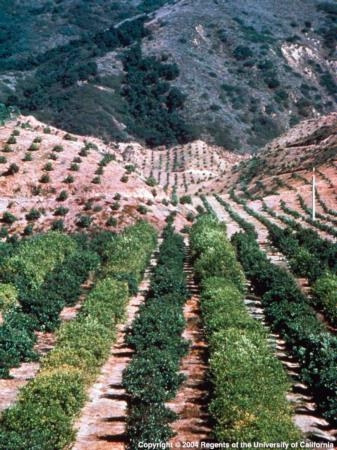Many orchards in California are planted on slopes, the most extreme examples are usually avocado orchards with some slopes exceeding 50%. They pose difficulties in harvesting because of the steepness, but also in their irrigation. These slopes can be north/south/east/west facing or all of the quadrants in the same orchard. The plantings can be of varying steepness and at different positions (toe, top, mid-slope). These positions affect solar radiation which is the main driver of evapotranspiration, but also wind interception. South and west facing slopes intercept the most sunlight, while north and east intercept the least. The top of the slope usually intercepts the most sunlight during the day and also the most wind. There can be 100% difference in the amount of ET depending on the position on the slope. That is, some trees require twice as much water as others because they are getting more energy that drives water loss.
When looking at an older avocado grove, the trees are usually larger at the bottom of the slope where there is the least wind and most irrigation water interception. This is where the soil is the deepest and has the greatest moisture reserve. The soils at the top of the slope are the shallowest and get the greatest amount of energy driving water loss. Trees on the north side are often tall from greater soil depth and moisture reserve and less ET demand. As the solar angle changes during the year (lower in the sky during the winter), the proportion of ET in these different positions changes.
Right. OK. We know this. The problem is that many smaller orchards are laid out so that there is one valve controlling the amount of water going to all the different positions. The trees at the bottom of the slopes get the same as those at the top. Those on the north side get the same as those on the south side. This basically sets up an orchard for stress. Stress that leads to disease and impacts on yields and ultimately the longevity of the orchard.
Add to this, irrigation performance varies with pressure and many orchards have very little pressure compensation. Often trees at the top of the slope have the lowest pressure and output. The distribution uniformity is often terrible. Not only are the normal problems of broken and clogged emitters an issue, but also pressure loss from elevation differences.
So where you plant on a hillside should be part of the irrigation design. In different positions on the hillside there are different water requirements and unless they are irrigated differently, there can be major differences in tree response. These different irrigation requirements should be incorporated into the irrigation design by creating as many different irrigation blocks as possible. A valve for the top of the slope, another for the north and south slopes, etc. These can be incorporated easily in the initial design and not so easily customized after the trees have been planted.
At some point, for optimum tree performance, tree health and water use efficiency, growers should recognize the need for irrigating to trees' needs according to slope position. Avocado growers have it harder than most growers.
Read more about an ET study done on a hill:
http://www.avocadosource.com/CAS_Yearbooks/CAS_86_2002/cas_2002_pg_099-104.pdf
Attached Images:
